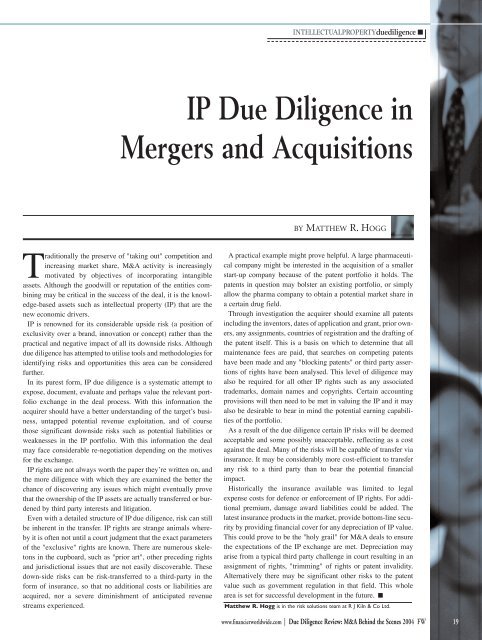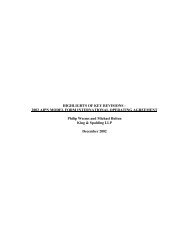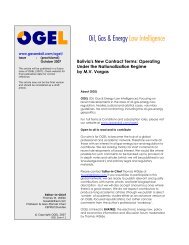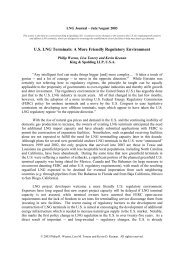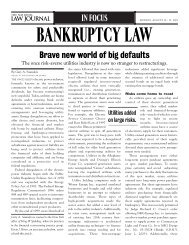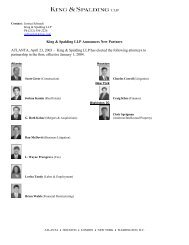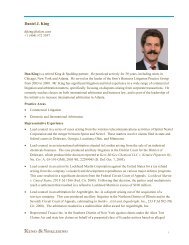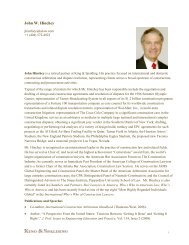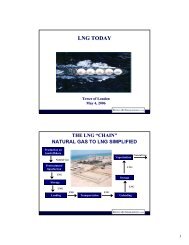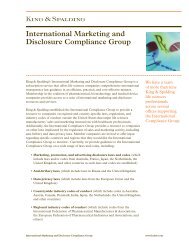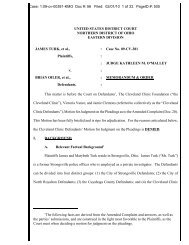Due Diligence Review: M&A Behind the Scenes - King & Spalding
Due Diligence Review: M&A Behind the Scenes - King & Spalding
Due Diligence Review: M&A Behind the Scenes - King & Spalding
Create successful ePaper yourself
Turn your PDF publications into a flip-book with our unique Google optimized e-Paper software.
INTELLECTUALPROPERTYduediligence<br />
IP <strong>Due</strong> <strong>Diligence</strong> in<br />
Mergers and Acquisitions<br />
BY MATTHEW R. HOGG<br />
Traditionally <strong>the</strong> preserve of "taking out" competition and<br />
increasing market share, M&A activity is increasingly<br />
motivated by objectives of incorporating intangible<br />
assets. Although <strong>the</strong> goodwill or reputation of <strong>the</strong> entities combining<br />
may be critical in <strong>the</strong> success of <strong>the</strong> deal, it is <strong>the</strong> knowledge-based<br />
assets such as intellectual property (IP) that are <strong>the</strong><br />
new economic drivers.<br />
IP is renowned for its considerable upside risk (a position of<br />
exclusivity over a brand, innovation or concept) ra<strong>the</strong>r than <strong>the</strong><br />
practical and negative impact of all its downside risks. Although<br />
due diligence has attempted to utilise tools and methodologies for<br />
identifying risks and opportunities this area can be considered<br />
fur<strong>the</strong>r.<br />
In its purest form, IP due diligence is a systematic attempt to<br />
expose, document, evaluate and perhaps value <strong>the</strong> relevant portfolio<br />
exchange in <strong>the</strong> deal process. With this information <strong>the</strong><br />
acquirer should have a better understanding of <strong>the</strong> target’s business,<br />
untapped potential revenue exploitation, and of course<br />
those significant downside risks such as potential liabilities or<br />
weaknesses in <strong>the</strong> IP portfolio. With this information <strong>the</strong> deal<br />
may face considerable re-negotiation depending on <strong>the</strong> motives<br />
for <strong>the</strong> exchange.<br />
IP rights are not always worth <strong>the</strong> paper <strong>the</strong>y’re written on, and<br />
<strong>the</strong> more diligence with which <strong>the</strong>y are examined <strong>the</strong> better <strong>the</strong><br />
chance of discovering any issues which might eventually prove<br />
that <strong>the</strong> ownership of <strong>the</strong> IP assets are actually transferred or burdened<br />
by third party interests and litigation.<br />
Even with a detailed structure of IP due diligence, risk can still<br />
be inherent in <strong>the</strong> transfer. IP rights are strange animals whereby<br />
it is often not until a court judgment that <strong>the</strong> exact parameters<br />
of <strong>the</strong> "exclusive" rights are known. There are numerous skeletons<br />
in <strong>the</strong> cupboard, such as "prior art", o<strong>the</strong>r preceding rights<br />
and jurisdictional issues that are not easily discoverable. These<br />
down-side risks can be risk-transferred to a third-party in <strong>the</strong><br />
form of insurance, so that no additional costs or liabilities are<br />
acquired, nor a severe diminishment of anticipated revenue<br />
streams experienced.<br />
A practical example might prove helpful. A large pharmaceutical<br />
company might be interested in <strong>the</strong> acquisition of a smaller<br />
start-up company because of <strong>the</strong> patent portfolio it holds. The<br />
patents in question may bolster an existing portfolio, or simply<br />
allow <strong>the</strong> pharma company to obtain a potential market share in<br />
a certain drug field.<br />
Through investigation <strong>the</strong> acquirer should examine all patents<br />
including <strong>the</strong> inventors, dates of application and grant, prior owners,<br />
any assignments, countries of registration and <strong>the</strong> drafting of<br />
<strong>the</strong> patent itself. This is a basis on which to determine that all<br />
maintenance fees are paid, that searches on competing patents<br />
have been made and any "blocking patents" or third party assertions<br />
of rights have been analysed. This level of diligence may<br />
also be required for all o<strong>the</strong>r IP rights such as any associated<br />
trademarks, domain names and copyrights. Certain accounting<br />
provisions will <strong>the</strong>n need to be met in valuing <strong>the</strong> IP and it may<br />
also be desirable to bear in mind <strong>the</strong> potential earning capabilities<br />
of <strong>the</strong> portfolio.<br />
As a result of <strong>the</strong> due diligence certain IP risks will be deemed<br />
acceptable and some possibly unacceptable, reflecting as a cost<br />
against <strong>the</strong> deal. Many of <strong>the</strong> risks will be capable of transfer via<br />
insurance. It may be considerably more cost-efficient to transfer<br />
any risk to a third party than to bear <strong>the</strong> potential financial<br />
impact.<br />
Historically <strong>the</strong> insurance available was limited to legal<br />
expense costs for defence or enforcement of IP rights. For additional<br />
premium, damage award liabilities could be added. The<br />
latest insurance products in <strong>the</strong> market, provide bottom-line security<br />
by providing financial cover for any depreciation of IP value.<br />
This could prove to be <strong>the</strong> "holy grail" for M&A deals to ensure<br />
<strong>the</strong> expectations of <strong>the</strong> IP exchange are met. Depreciation may<br />
arise from a typical third party challenge in court resulting in an<br />
assignment of rights, "trimming" of rights or patent invalidity.<br />
Alternatively <strong>the</strong>re may be significant o<strong>the</strong>r risks to <strong>the</strong> patent<br />
value such as government regulation in that field. This whole<br />
area is set for successful development in <strong>the</strong> future.<br />
Mat<strong>the</strong>w R. Hogg is in <strong>the</strong> risk solutions team at R J Kiln & Co Ltd.<br />
www.financierworldwide.com | <strong>Due</strong> <strong>Diligence</strong> <strong>Review</strong>: M&A <strong>Behind</strong> <strong>the</strong> <strong>Scenes</strong> 2004 FW 19


